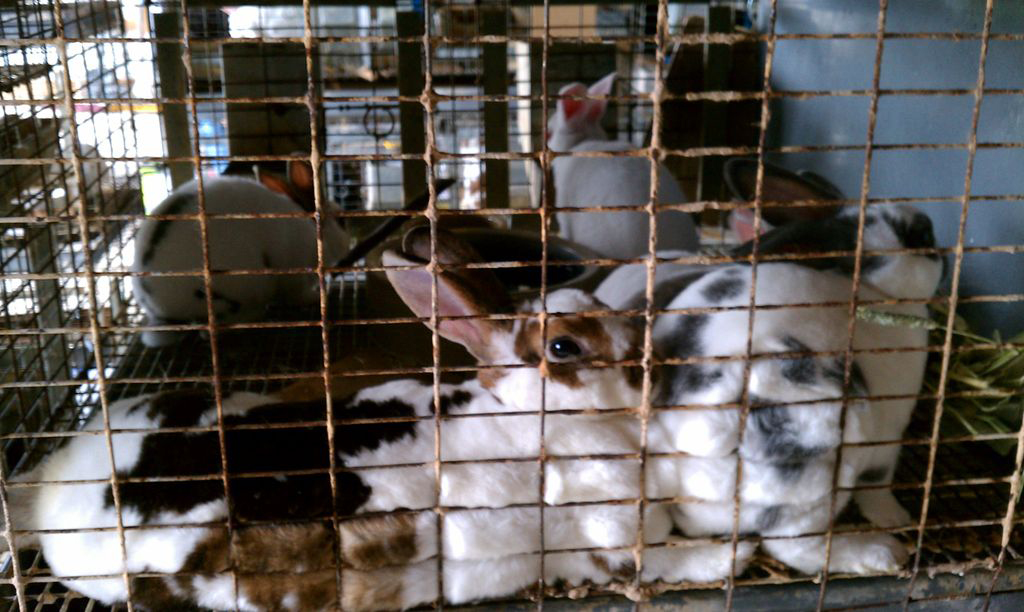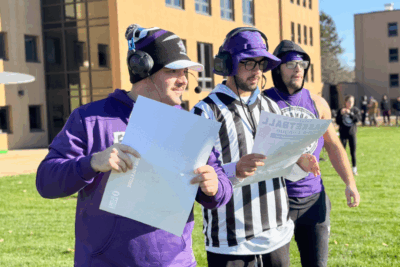Easter is not the favorite time of year for rabbit lovers. For members of the House Rabbit Society, or HRS, Easter is only the beginning of a flood of unwanted Easter bunnies.
Dawn Sailer is the chapter manager for the Indiana House Rabbit Society, or IHRS. She says that she and volunteers receive unwanted rabbits in the months following Easter as the rabbits reach sexual maturity.The rabbits are no longer the docile babies that parents placed in Easter baskets, but may begin to act aggressively as they become territorial. The mature rabbits also develop an instinct to dig and mark territory with urine.
While some of these rabbits are surrendered to the Humane Society or rescues, many end up abandoned in the streets.
“What we really try to raise awareness of is that when a rabbit is released in the wild to fend for itself, it is essentially a death sentence,” Sailer said.
She adds that it is also a felony in the state of Indiana.
The HRS is a nonprofit rescue and education organization founded in 1988 by seven rabbit owners from California.
On the HRS website, Beth Woolbright, a founding member, said that their mission “was based on two observations: that people needed to be educated about the needs of real rabbits, and that there were rabbits in shelters that need good homes.”
The founding of the HRS was preceded by the publishing of the book “House Rabbit Handbook: How to Live with an Urban Rabbit” by Marinell Harriman, a founding member. Now in its fifth edition, “House Rabbit Handbook” is essentially the bible for house rabbit owners, detailing how to provide proper nutrition, bunny-proof your home and get the most out of your rabbit’s unique personality.
While housing a rabbit in a cage indoors may not be a foreign concept, members of the HRS often take things a step forward. House rabbits might live in anything from a multi-level “bunny-condo” to having free run of the entire house, much like a dog or cat would.
Katrina Rios of Middlebury is one such rabbit owner. Her 3-year-old lop mix, Lumi, does not live in a cage.
“I tell Lumi how lucky she is to sun bathe. Not all bunnies get to do that,” Rios said as she petted Lumi, who was sitting on the couch next to Rios and watching cartoons.
Lumi is Rios’s second rabbit. Although Rios kept her first rabbit, Sonic, in a cage she realized that Lumi would be happier if she had more room.
“I came home one day and I thought she just looked so sad. I took that cage off and she has never been in it since,” Rios said. “Now she’s our dream bunny because she can do everything with us. She is loose all day and doesn’t get into anything.”
Rios does admit that she is lucky to have such a well-behaved rabbit.
“As long as she has paper to shred she stays out of trouble,” Rios added.
Sailer adopted her first rabbit in 1997, from the Chicago chapter of the HRS. When she moved to Indianapolis she connected with other house rabbit owners. Sailer and five others decided to found the Indiana House Rabbit Society in 2001.
In the beginning, Sailer would appear on the local news shows once a month with rabbits from the Indianapolis Humane Society and educate viewers about proper rabbit care.
“Of course it was things like rabbits need to be spayed or neutered; they don’t like to be held,” Sailer said. “I preached all of the standard rabbit stuff. There might be six to eight rabbits in the shelter and hours later there would be zero.”
However, nowadays, rabbits are not finding homes as easily. The HRS says that rabbits are the third most popular pet, which means they are also the third most common in shelters.
Most branches of the Humane Society are not equipped to care for rabbits, and staff and volunteers are not familiar with their needs. In some places the Humane Society does not even accept surrendered rabbits, instead turning the animals over to rescues that specialize in small animals.
This past year, 2013, was an especially hectic year for the Indiana House Rabbit Society. They took part in three major rescue operations in Indiana.
The first rescue consisted of 12 rabbits being taken from a rundown farm in Summitville where they were kept in deplorable conditions with several other species. Approximately 100 animals were found dead on the property. The conditions were so bad that rescuers had to wear hazmat suits. The incident made national news.
“So [this case], while it didn’t have as much rabbits, they were in far worse shape,” Sailer recalled.
The other two rescues involved breeders who kept hundreds of rabbits in walls of cramped, dirty cages. The rabbits were exposed to extreme temperatures while covered in their own filth. Over 400 were seized during July and over 200 were seized in December. In both of these cases, the rabbits were kept in homes in the city.
With many foster homes already filled, IHRS turned to other chapters and independent rescues for help. House rabbit owners everywhere came to their aid. As many as 30 other rescues, from across the country, took in the rabbits.
“[They came from] as far west as California, as far north as Minnesota, as far east as Maine and as far south as Georgia and Texas,” Sailer said. “If that gives you an idea of the breadth.”
Now, IHRS is coming to the aid of rabbits from West Virginia. Over 200 rabbits were confiscated from a breeder on Friday, April 4.
While vacationing in Nepal, Sailer orchestrated the transportation of some of the rescued rabbits. Volunteers picked up the rabbits in Pittsburgh, PA and brought them back to Indianapolis where they will be placed in foster homes.
The IHRS is also preparing for the influx of unwanted Easter bunnies with a fundraising event. They will hold their 7th annual adults only Easter egg hunt on April 19 in Carmel. The $5 admission will help the IHRS pay for food and vet bills for the rabbits in foster care.
For more info on the IHRS visit indianahrs.org.
My house rabbit experience
In 2011, I decided I wanted a pet. Because of my living situation, a cat or dog would not work. Remembering that I once had rabbits as a small child, I decided I would adopt a rabbit from the Elkhart Humane Society.
My fiancé had other ideas. He was so eager for me to get a rabbit that he bought one for me: a 4-month-old solid black Mini Rex. I named her Umbra.
At first she was calm and shy, like I wrongly assumed all rabbits were. She soon showed me otherwise.
In a couple of months Umbra became a “teenager” and began showing her true colors. She was bossy, impatient and noisy. I had not even realized rabbits made noises. Mostly Umbra growled when a treat was not given fast enough or made soft affectionate “honks” when she wanted attention. She also developed a deep-seeded and irrational hatred of my fiancé, Shannon.
Nearly three years later, Umbra is still 4lbs of sass. She loves to steal pencils and eat the erasers and sleeps at the foot of the bed. I get kisses every night and every morning, but if I do not wake up at precisely 5 a.m. Umbra will pull my hair.
Umbra does not play with any of the toys I have bought her. She prefers sunglasses, plastic cutlery and clothes hangers. Like all rabbits, not all of her natural inclinations mesh well with living in a house; she does chew on cords and furniture and tries to tunnel through the carpet. But as time has passed, I have gotten better at bunny-proofing.
Then there is the money. Not many veterinarians are trained to treat rabbits, so vet bills tend to be higher. Having to provide a constant supply of Timothy Hay and fresh, organic produce can be pricy too.
At times owning a house rabbit can be frustrating, but I cannot imagine life without Umbra. I am glad to have had the opportunity to learn so much about this often misunderstood animal.



